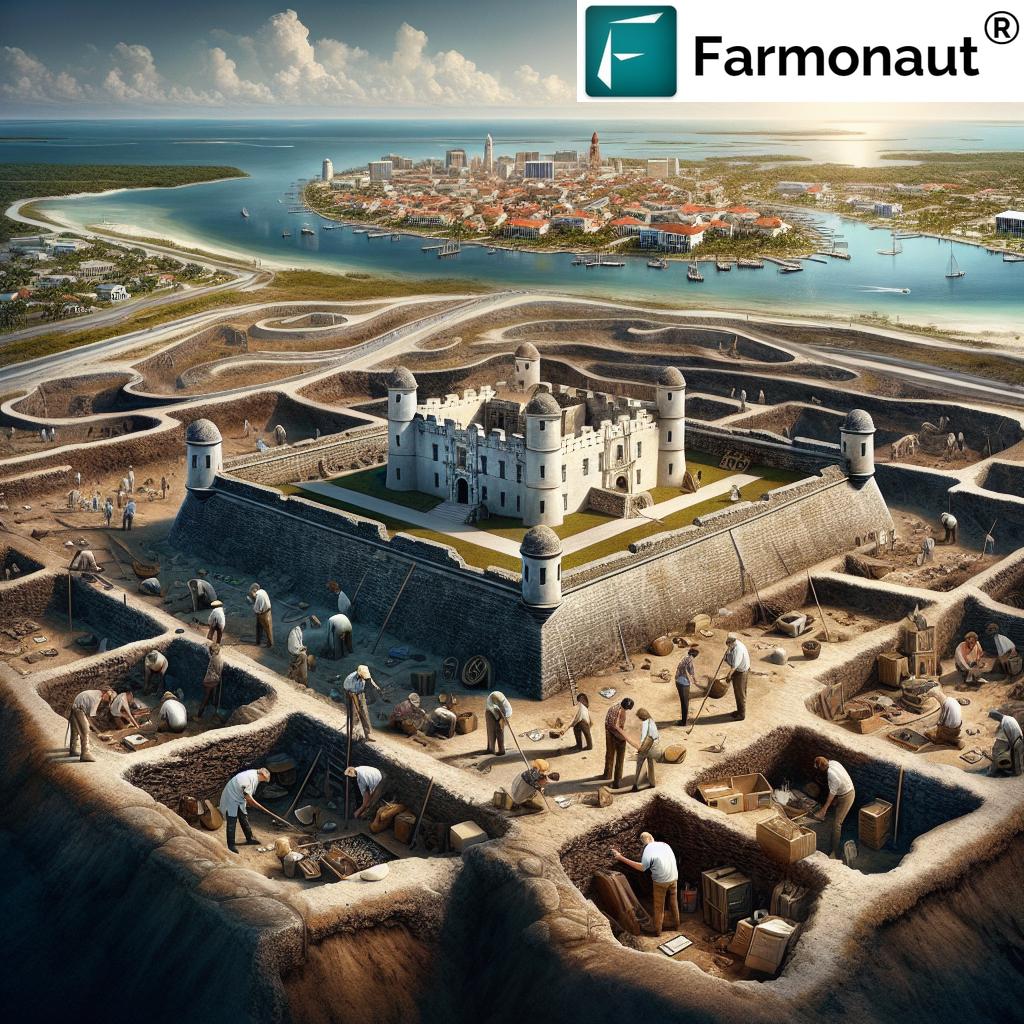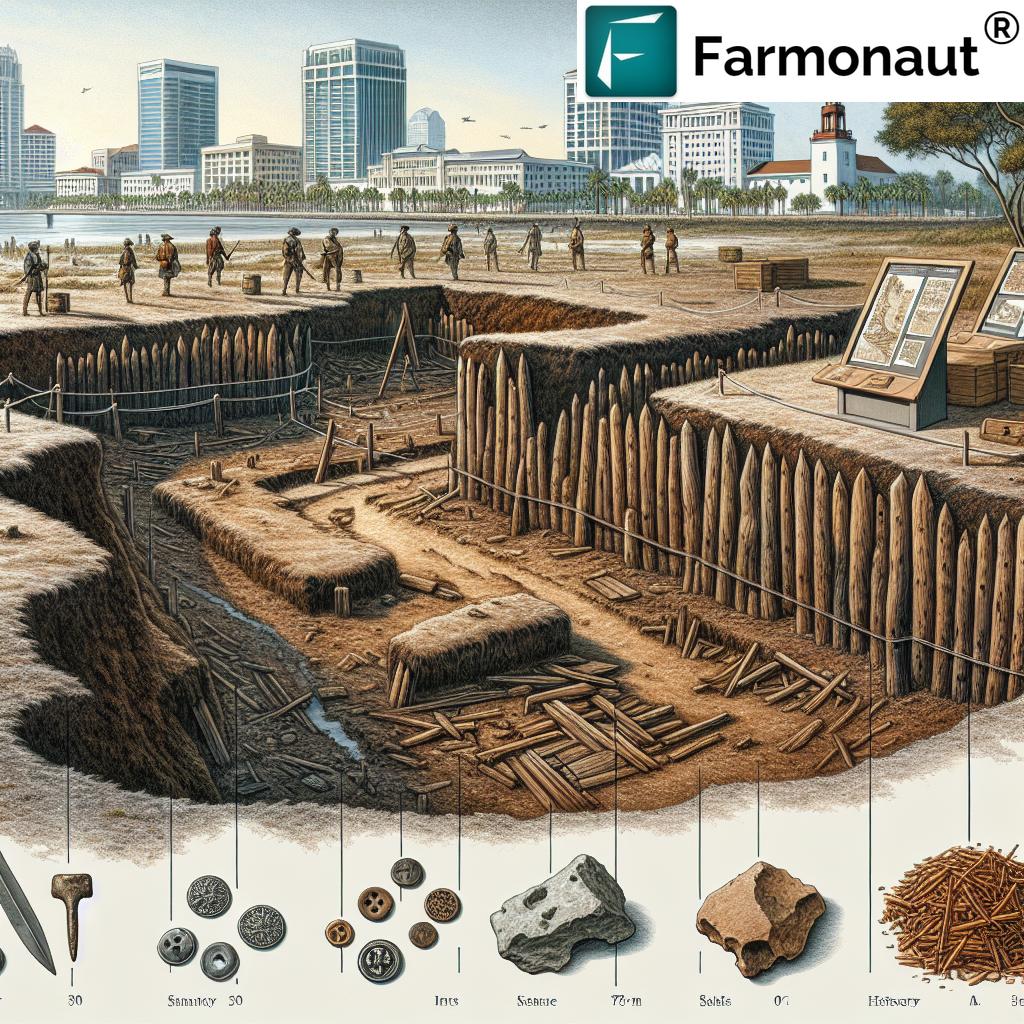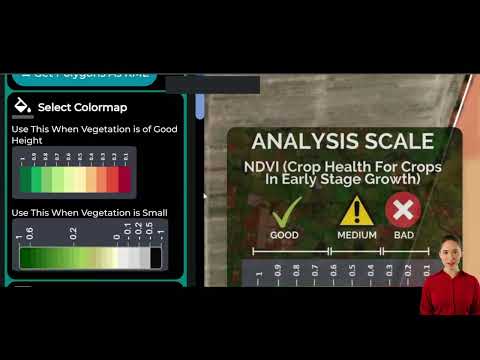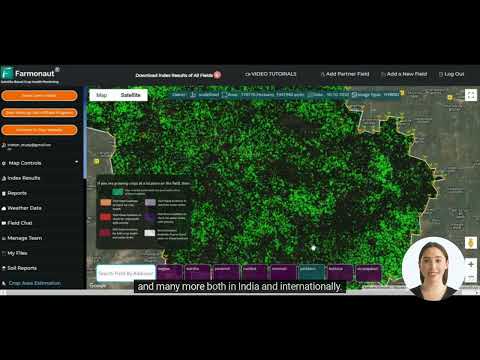Uncovering History: Archaeological Discoveries Reveal British Fort in St. Augustine, Florida’s Oldest City
“St. Augustine’s archaeological preservation ordinance has led to over 1,200 projects, uncovering centuries of history.”
Welcome to a journey through time as we explore the fascinating archaeological discoveries in St. Augustine, Florida’s oldest city. Our team at Farmonaut, while primarily focused on agricultural technology, recognizes the importance of understanding our historical roots and the innovative techniques used to uncover them. Join us as we delve into the rich tapestry of St. Augustine’s past, where centuries-old buildings and a massive stone fort stand as enduring reminders of Spain’s storied history in Florida.
The Unveiling of a British Colonial Fort
In a groundbreaking discovery that has sent ripples through the archaeological community, city archaeologists have recently identified a dry moat of a British redoubt, a fortified military outpost constructed in 1781. This remarkable find, unearthed in the fall of 2024 in St. Augustine’s Lincolnville neighborhood, sheds light on a forgotten 20-year period of British occupation.

City archaeologist Andrea White explains, “St. Augustine had a 20-year British period. They came, and they built seven of these redoubts, and nobody has ever found any archaeologically. We have rough ideas of where they were, and they show up on historic maps. But we’ve never found actual, tangible, archaeological evidence for any of them until recently.”
The Historical Context of St. Augustine
To truly appreciate this discovery, we must first understand the rich history of St. Augustine. Founded in 1565, it is the oldest continuously occupied European settlement in the United States. The city’s iconic Castillo de San Marcos, built by the Spanish military in the late 1600s, still stands on the western shore of Florida’s Matanzas Bay, now serving as a national monument rather than a military installation.
When the British took control of Florida in 1763, St. Augustine already boasted extensive Spanish-built defenses. However, British officers, concerned about potential attacks from a nearby river, ordered the construction of outposts along the city’s western edge.
The Significance of the British Redoubt
White emphasizes the unique nature of this discovery: “That’s what’s interesting about these British redoubts, they’re the only defenses that the British built themselves. Everything else that’s in St. Augustine or the surrounding area that everyone’s familiar with, those were already built by the Spanish. And then the British just kind of reoccupied them.”
This newly unearthed fort offers a tangible link to a period of St. Augustine’s history that has been largely forgotten by time. It provides an opportunity to reclaim a piece of lost history and better understand the city’s complex past.
St. Augustine’s Unique Archaeological Preservation Ordinance
The discovery of this British fort was made possible thanks to a unique archaeological preservation ordinance adopted by St. Augustine in 1986. This forward-thinking policy recognizes the city’s immense historical value and ensures that development projects are balanced with the need to document and preserve archaeological resources.
As part of the city’s planning and permitting department, the archaeology program has completed over 1,200 projects in the past four decades. These excavations have not only uncovered evidence from Spanish colonial times but also revealed Native American settlements and villages dating back 4,000 years.
The Excavation Process
The archaeological team knew the area under development had a long and varied history, including a Native American mission in the early 1700s, followed by an agricultural plantation, and after the Civil War, the construction of the Lincolnville neighborhood. However, the discovery of the British fort was an exciting surprise.
White describes the find: “What we found evidence of was a large moat about 15 feet wide that would have been part of the rampart.” While few artifacts were recovered at the site, and the fort’s actual size and shape remain uncertain, the team did collect thousands of different types of seeds.
Innovative Use of Plants in Fortifications
One of the most intriguing aspects of this discovery is the potential insight it offers into historical plant use in military structures. The archaeological team is working with a paleoethnobotanist to study how plants might have been used in the construction and maintenance of the fort.
White speculates, “It’s possible that plants like Spanish bayonet or prickly pear cactuses were used to prevent erosion or to slow down attacking soldiers. We’re very hopeful that we might find some good information from our plant remains that we’ve recovered.”
This innovative use of plants in fortifications reminds us of the importance of understanding the relationship between humans and their environment throughout history. At Farmonaut, we recognize the crucial role that plants play in our world, which is why we offer advanced crop plantation and forest advisory services to help modern farmers optimize their agricultural practices.
Balancing Development and Preservation
The discovery of the British fort highlights the delicate balance between urban development and historical preservation. Jason Heidgerken, the contractor working on the lot where the fort’s moat was found, acknowledges that the city’s archaeological program can cause delays but emphasizes the importance of patience when working in such a historically rich area.
“I’ve been around St. Augustine since 1980 personally, and part of the attraction is the history,” Heidgerken says. “So if you want to live there and do this kind of business, it’s to be expected, and you need to have the patience for it.”

This approach to development, which values both progress and preservation, is something we at Farmonaut can appreciate. Our carbon footprinting services help agricultural businesses monitor and reduce their environmental impact, allowing for sustainable growth while respecting our planet’s resources.
The Broader Impact of Archaeological Discoveries
The unearthing of this British fort in St. Augustine is more than just a local curiosity; it has broader implications for our understanding of colonial history in North America. It provides tangible evidence of the complex interactions between European powers in the New World and offers insights into military strategies and technologies of the 18th century.
Moreover, these discoveries contribute to a more nuanced understanding of the multicultural heritage of the United States. St. Augustine’s history encompasses Native American, Spanish, British, and early American periods, making it a microcosm of the nation’s diverse roots.
Timeline of Archaeological Discoveries in St. Augustine
| Year | Discovery | Significance |
|---|---|---|
| 1565 | Founding of St. Augustine | Oldest continuously occupied European settlement in the US |
| 1672-1695 | Construction of Castillo de San Marcos | Oldest masonry fort in the continental US |
| 1763 | British occupation begins | Start of 20-year British period in St. Augustine |
| 1781 | Construction of British redoubts | Addition of fortifications during British rule |
| 1986 | Archaeological preservation ordinance adopted | Establishment of city’s archaeology program |
| 2024 | Discovery of British redoubt moat | First archaeological evidence of British fortifications |
The Role of Technology in Modern Archaeology
While our discussion has focused on historical discoveries, it’s worth noting the crucial role that modern technology plays in contemporary archaeological research. At Farmonaut, we understand the power of technological innovation in uncovering hidden information, albeit in a different field.
Our satellite-based crop health monitoring services, for instance, use multispectral imagery to reveal crucial information about vegetation health and soil moisture levels. While archaeologists use ground-penetrating radar and LiDAR to uncover buried structures, we use similar principles of remote sensing to help farmers optimize their crop management strategies.
“The recently discovered British fort in St. Augustine dates back to 1781, revealing a forgotten 20-year period of occupation.”
Preserving History for Future Generations
The discovery of the British fort in St. Augustine serves as a powerful reminder of the importance of preserving our historical heritage. Just as we at Farmonaut strive to preserve and optimize agricultural resources for future generations, archaeologists and historians work tirelessly to uncover and protect the relics of our past.
This commitment to preservation extends beyond physical artifacts. In the digital age, preserving historical data is equally important. At Farmonaut, we understand this principle well, which is why we offer blockchain-based traceability solutions that ensure the integrity and transparency of agricultural supply chains.
The Future of Archaeological Research in St. Augustine
As exciting as the discovery of the British fort is, it’s clear that St. Augustine still has many secrets to reveal. The city’s unique preservation ordinance ensures that future development projects will continue to uncover new pieces of the historical puzzle.
White and her team are eager to continue their work, hoping to locate more of the British redoubts and uncover further evidence of the city’s multicultural past. Each new discovery adds another layer to our understanding of St. Augustine’s rich history and, by extension, the early history of the United States.
Lessons from the Past for a Sustainable Future
As we reflect on the archaeological discoveries in St. Augustine, we’re reminded of the importance of understanding our past to build a better future. At Farmonaut, we apply this principle to agriculture, using cutting-edge technology to learn from historical data and optimize farming practices for sustainability.
Our crop loan and insurance services, for instance, use satellite-based verification to reduce fraud and improve access to financing for farmers. This modern application of technology echoes the innovative spirit of those who built the fortifications we’re now uncovering in St. Augustine.
Connecting Past and Present
The story of St. Augustine’s British fort is a testament to the enduring human spirit of innovation and adaptation. From the Spanish colonists who built the Castillo de San Marcos to the British soldiers who constructed their redoubts, each generation left its mark on the landscape.
Today, we continue this tradition of innovation in new ways. At Farmonaut, we’re proud to be part of this ongoing story, using satellite technology and AI to help farmers around the world optimize their practices and contribute to a more sustainable future.
Conclusion: The Ongoing Journey of Discovery
As we conclude our exploration of St. Augustine’s archaeological treasures, we’re reminded that the journey of discovery is never truly over. Whether we’re uncovering centuries-old fortifications or developing new agricultural technologies, the spirit of curiosity and innovation continues to drive us forward.
We invite you to join us in this ongoing journey of discovery. Whether you’re a history enthusiast fascinated by archaeological finds or a farmer looking to optimize your crop management, there’s always something new to learn and explore.
FAQs
- What is the significance of the British fort discovery in St. Augustine?
The discovery provides tangible evidence of the 20-year British occupation period in St. Augustine, filling a gap in our understanding of the city’s colonial history. - How old is St. Augustine?
St. Augustine was founded in 1565, making it the oldest continuously occupied European settlement in the United States. - What is a redoubt?
A redoubt is a fortified military outpost, typically used to provide additional defense for a larger fortification or strategic area. - How does St. Augustine’s archaeological preservation ordinance work?
The ordinance requires archaeological assessment and documentation before construction projects can proceed, allowing for the preservation of historical artifacts and structures. - What other historical periods are represented in St. Augustine’s archaeological record?
St. Augustine’s archaeological sites span from Native American settlements dating back 4,000 years to Spanish colonial times, the British period, and early American history.
For those interested in modern applications of technology in agriculture, we encourage you to explore Farmonaut’s innovative solutions:
Earn With Farmonaut: Affiliate Program
Earn 20% recurring commission with Farmonaut’s affiliate program by sharing your promo code and helping farmers save 10%. Onboard 10 Elite farmers monthly to earn a minimum of $148,000 annually—start now and grow your income!






